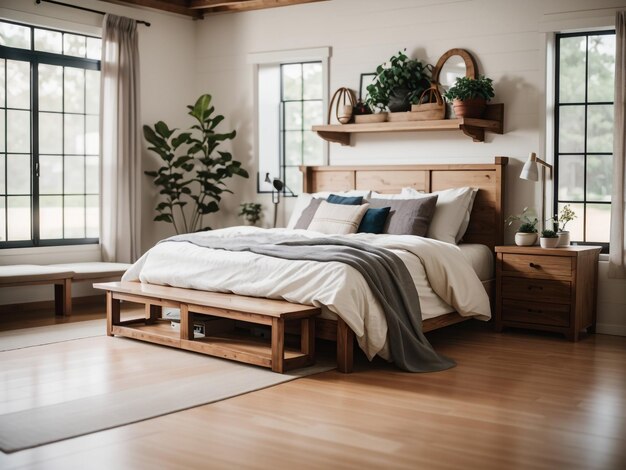
Farmhouse Design is experiencing a surge in popularity, blending the warmth and charm of rustic country homes with the sleek functionality of modern interiors. This style, drawing inspiration from classic farmhouses, offers a welcoming and inviting atmosphere perfect for creating a cozy haven. However, achieving this balance between rustic and modern can be challenging for many homeowners. This article explores the key elements of Farmhouse Design, from choosing the right materials to arranging furniture in a harmonious way, guiding you through the process of crafting a space that seamlessly combines both rustic and modern elements. This thorough guide will delve into creating a space that seamlessly integrates both styles, resolving your design dilemmas and providing practical advice for your farmhouse design journey.
Defining Farmhouse Design: A Blend of Styles
Understanding the Core Principles
Farmhouse design, at its heart, is a harmonious marriage of rustic and modern aesthetics. It draws inspiration from traditional farmhouses, emphasizing natural elements, warm tones, and functional design. This blend creates a welcoming and inviting atmosphere, ideal for creating a cozy home. The key is to maintain a balance between the raw, natural beauty of the farmhouse roots and the contemporary comforts of modern living. This blend creates a unique and personalized space, a space reflecting your unique taste. This style is all about finding a perfect balance in each room. Furthermore, the aesthetic often involves the use of natural materials like wood, stone, and exposed beams, which add depth and texture to the space. The use of soft, warm colors, like natural beiges, creams, and warm grays, further accentuates the cozy atmosphere.
Choosing the Right Materials and Colors
Natural Materials for a Rustic Touch
The core of Farmhouse Design lies in using natural and often reclaimed materials. Think distressed wood, stone countertops, exposed brick, and woven textiles. These elements are carefully selected to create a warm and inviting ambiance. Utilizing reclaimed wood, for instance, adds an element of history and character to any room. Stone countertops in kitchens, bathrooms, and even living areas contribute a sense of grounded luxury. The incorporation of these materials allows for a unique expression, a way to showcase personality and individual taste. When it comes to wall colors, soft, warm tones like cream, beige, or light gray are prevalent choices. These muted hues establish a backdrop that seamlessly integrates the natural materials.
Furniture Arscopements and Layouts
Creating a functional and Cozy Space
A key element of farmhouse design is creating functional and cozy spaces. Using an open idea plan promotes a sense of spaciousness. Layering furniture, particularly with diverse textures and patterns, creates depth and interest. Adding natural accents, such as woven baskets, throws, and plants, enhances the rustic charm. Furniture pieces should be carefully chosen to enhance the overall aesthetic, not overwhelm it. To give the home a welcoming atmosphere, consider utilizing lighting options that softly illuminate each space. Large window placements in living rooms and bedrooms create a beautiful blend of outdoor and indoor living.
Accenting with Natural Elements
Integrating Nature into Your Decor
Integrating natural elements is fundamental to Farmhouse Design. Plants, wood accents, and natural textiles add depth and life to the space. Think lush indoor gardens, potted plants in a scope of sizes, natural fibers, or even reclaimed wood accents. These additions can not only enhance the visual appeal of the space, but also introduce calming elements into each room. The incorporation of these touches fosters a sense of tranquility and connection to the natural world. When used appropriately, these touches create an atmosphere that’s both inviting and sophisticated.
Integrating Modern Elements
Modern Comfort Meets Rustic Charm
Despite the rustic theme, Farmhouse Design isn’t afraid to incorporate modern elements to maintain a balance. This is especially crucial when using natural materials. Modern kitchens, for example, use sleek appliances, while maintaining the overall rustic theme through wooden cabinetry and natural-toned tiles. Modern lighting options can help balance the warmth of traditional fixtures. Modern lighting can introduce a touch of elegance while maintaining the core aesthetic. Utilizing neutral colors ensures a cohesive integration of rustic and modern elements.
Creating a Budget-Friendly Farmhouse Design
Farmhouse Design for Small Spaces
Maximizing Natural Light in Farmhouse Design
In conclusion, Farmhouse Design offers a compelling blend of rustic charm and modern comfort, appealing to a wide scope of homeowners. By understanding the core principles of this style, and carefully considering your space’s unique characteristics, you can create a home that reflects your personal style while maintaining a timeless appeal. Ready to bring the farmhouse aesthetic into your home? Contact us today for a personalized design consultation.